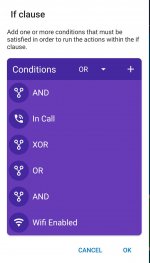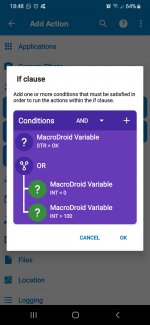hello,
in an if when there are more than 2 conditions there is a drop-down to choose between AND , OR
I guess this means that it will consider the AND or OR of all conditions
this is understandable and fine
however as conditions I can choose
AND, OR, XOR, NOT clauses !!
which are displayed with () after them and it's confusing to me if they are logical clauses between the other if conditions (together with the above AND, OR ??) or something else ?
can anyone describe their purpose ?
see attached pic for example which I made as a random demo
what does it mean ?
in an if when there are more than 2 conditions there is a drop-down to choose between AND , OR
I guess this means that it will consider the AND or OR of all conditions
this is understandable and fine
however as conditions I can choose
AND, OR, XOR, NOT clauses !!
which are displayed with () after them and it's confusing to me if they are logical clauses between the other if conditions (together with the above AND, OR ??) or something else ?
can anyone describe their purpose ?
see attached pic for example which I made as a random demo
what does it mean ?

